Love-Death and Transfiguration
 Tristan (Stuart Skelton) with Isolde (Nina Stemme) at the Met Opera (Photo: New York Times)
Tristan (Stuart Skelton) with Isolde (Nina Stemme) at the Met Opera (Photo: New York Times)
The Metropolitan Opera radio broadcast of Tristan und Isolde on April 8, 2017 (the original program was shown as part of its Live in HD series on October 8, 2016) paired Swedish soprano Nina Stemme as Isolde with Australian dramatic tenor Stuart Skelton as Tristan. Others in the cast included Moscow-born mezzo-soprano Ekaterina Gubanova as Isolde’s companion Brangäne, Russian bass-baritone Evgeny Nikitin as Tristan’s aide Kurwenal, and German bass-baritone René Pape as Tristan’s foster father King Marke. Tony Stevenson sang the part of the Sailor in Act I, with Neal Cooper as Melot in Act II, and Alex Richardson as the Shepherd in Act III. The work was conducted by renowned British maestro Sir Simon Rattle.
This was a new production, credited to the controversial Polish-born director Mariusz Treliński, whose previous assignment at the Met included the double bill of Tchaikovsky’s Iolanta with Bartók’s Bluebeard’s Castle. The sets were designed by Boris Kudlička, with costumes by Marek Adamski, lighting design by Marc Heinz, and choreography by Tomasz Wygoda. The Met’s chorus master, Donald Palumbo, did an outstanding job with the forces at his command.
Unlike past performances (over a quarter of a century, in fact) where former Met music director James Levine presided over an uncut reading, this version featured a nine-minute trim of the long second act duet for the title characters. Whether you’re a confirmed “complete-ist” as I tend to be, or whether you take your Wagner in shorter doses, the result was pretty much the same. Maybe Wagner’s music is overdue for a judicious paring — who am I to argue over his long-windedness, principally if this was going to be a late-night affair.
Having studied Wagner for years — and having owned numerous complete recordings and/or DVDs of all his major works — I uncovered boat-loads of reasons why he had his protagonists expound at length. Often, the characters felt the need to justify their past or present actions in some explanatory form. These expansive “speeches” were also used to recap prior happenings; or, just as often, they were employed to foretell future events (most notably in the Ring).
With Tristan und Isolde, Wagner divided the couple’s story into three distinct sections: Act I is taken up with Isolde’s dilemma and subsequent impasse over the love potion; Act II brings the two lovers together via their nocturnal yearnings; while Act III is devoted to Tristan’s delirium and Isolde’s love-death.
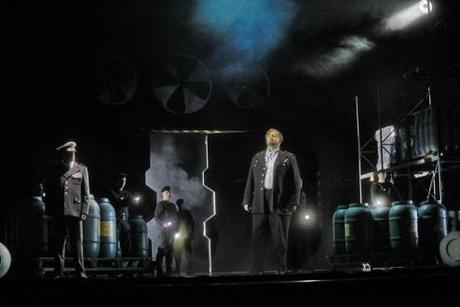
Simply stated, the plot involves the noble Tristan having killed the intended spouse (i.e., Morold) of the fiery Celtic princess Isolde. Seriously wounded in the battle, Tristan lies exposed as Isolde plans to seek payback for the slaying of her betrothed. However, once their eyes have met Isolde is unable to carry out her task. Later, Tristan is entrusted by King Marke (Tristan’s uncle, but in this production, his foster father) to bring Isolde back as Marke’s bride. All of this has taken place prior to the curtain’s rise.
Moving into the first act, Isolde relates the background (Isolde’s Narration and Curse) of what has occurred to this point. It becomes obvious that Isolde is passionately in love with Tristan, and vice versa. Because of stubborn pride and mutual bitterness over their recent state of affairs — for example, the humiliation that Isolde senses at being held captive by her “abductor,” Tristan — they adamantly refuse to acknowledge their feelings for one another. It also pains Tristan to have fallen hard for his uncle’s bride, with pangs of guilt preventing him from acting as Isolde thinks he should. Faced with a loveless marriage to a much older man, Isolde calls for a death potion to bring an end to their suffering. Brangäne, her companion (or maid in some versions), prepares the deadly concoction, only to substitute a love potion at the last minute.
In Act II, the lovers have been meeting in secret at night, the only time of the day allotted to them. Both are convinced of the inevitability of their love. Unable to consummate their relationship to the fullest, they resolve to end it in death — thus realizing Isolde’s original intention of having Tristan pay for killing Morold (which, by now, is the farthest thing from her mind). The problem, though, is that Marke, and his hunting party, discover the affair after the lovers’ ecstatic night of bliss. The King expresses his innermost thoughts on Tristan’s “betrayal” in a long, emotionally draining monolog. Ashamed of his conduct but resolved to take charge of the situation, Tristan invites Isolde to flee into the night (metaphorically speaking). In this production, he stabs himself, while in others the tattle-tale Melot (an interesting variant on Morold) seriously wounds Tristan as he deliberately lets down his guard.
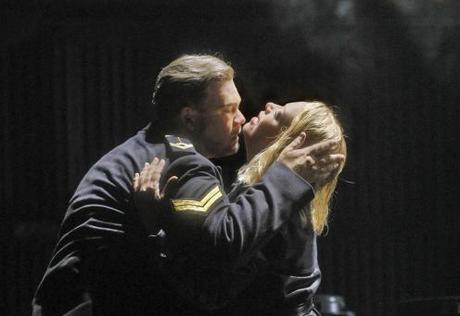
Act III takes place in Cornwall, Tristan’s ancestral home. Here we find him wailing and gnashing his teeth in agony and misery. Kurwenal, his aide and retainer, is nursing Tristan’s wound. He is unable to keep the knight quiet and calm. Tristan’s whose only desire is to expire in Isolde’s arms. Hearing that she is about to return and that Isolde has explained the situation to Marke (who is ready to forgive the despairing knight his sins) Tristan is beside himself with a mixture of joy and grief. In his final moments, Tristan tears away his bandages and bleeds to death, just as Isolde rushes in. Isolde then launches into her ecstatic Liebestod, which concludes the opera.
With such a tragedy unfolding before the viewer, it’s no wonder the most compelling aspect of this opera is its music: lush, propulsive, and chromatic to an unbearable degree. The world-famous Prelude sets the tone from the get-go, what with its enigmatic, unresolved opening notes. Know, too, that Wagner did not invent harmonics or chromaticism as it was employed here, nor did he discover “modern music” by chance. As musicologist and music historian Richard Taruskin has pointed out, in the Oxford History of Western Music, Wagner’s father-in-law, the concert pianist and composer Franz Liszt, was one of the earliest Western artists to utilize the diatonic scale, specifically what came to be known as the “Tristan chord.”
Taruskin goes on to say (in Defining Russia Musically: Historical and Hermeneutical Essays), that Wagner, referring to the Prelude, “leaves it for our inner ear to supply [the ultimate repose], so that the actual sounding music retains a restless harmonic tension at all times, virtually until the end of the opera, when all the accumulated pressure is at last discharged in Isolde’s Verklärung (“Transfiguration”), popularly known as the Liebestod, the death-by-love or, in plainer language, the orgasm.” Gasp!
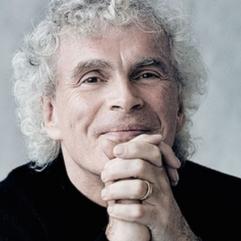
It’s a well-known truism that Tristan und Isolde has been labeled a conductor’s opera. And one could quibble over minor details here and there. Still, Sir Simon’s approach to Tristan was leaner in shape and conception than many of his predecessor’s. It made its points clearly and succinctly, without sacrificing lushness or the orchestral sheen surrounding the Metropolitan Opera Orchestra. Daniel Barenboim, who made his Met debut conducting Tristan in November 2008, set the standard, as far as I’m concerned, for how this work should be played in a large auditorium. Not to take away any of James Levine’s accomplishments, Barenboim made the case for a more leisurely elucidation, bringing out added resonance in the string section, as well as the ethereal essence in the final chords as Isolde expires over the dead body of her lover.
Rattle, for his part, succeeded in forging a viable (and valuable) interpretation of his own, with carefully controlled dynamics and an overwhelmingly positive energy flow (especially in Act I), in addition to a strong, emotional undercurrent in Act III, where Stuart Skelton, a supremely gifted Tristan in both physical size and specificity, scaled the heights in his powerful monolog.
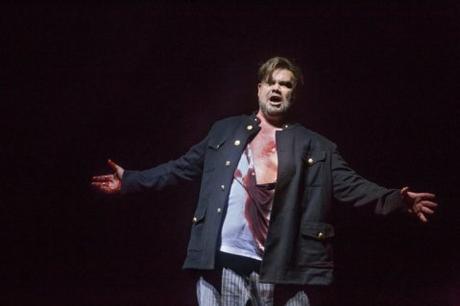
Skelton stretched his imposing instrument almost to the breaking point, in what became one of the most moving deliriums this listener has heard in many years of broadcast listening. The last time I was privy to such a marvelous take on the grueling part was Robert Dean Smith’s last minute substitution back in 2008. You can also pencil in Ben Heppner’s assumption of the part, another masterly effort.
It’s Always Darkest before the Dawn
Like most Tristans, Skelton made his mark in Act I, dueling with the skittish yet histrionically infuriated Isolde of Nina Stemme. Stemme, whose chief competitor in this repertoire today may be the memory of her Swedish compatriot, the late Birgit Nilsson (dubbed “Queen of the High Cs”), brought the Celtic princess to vibrant life. Certainly the Met’s Nordic contingent, which also included Kirsten Flagstad and Astrid Varnay, was well represented in Ms. Stemme.
In her recent Met assignments, Stemme conveyed hitherto untold nuances as Puccini’s Turandot; she was also an elemental force of nature in Strauss’ Elektra. As Isolde, her innate femininity and command of the many declamatory passages Wagner provided throughout gave Stemme ample opportunity for expressive singing of the highest order. This was as solidly delivered a performance of the part as any in the last decade, upstaging previous Met Opera exponents such as Deborah Voigt, Katarina Dalayman, and Jane Eaglen.
Both Gubanova and Nikitin held up their end, with Gubanova especially effective in her Act II warning. The lone standout, however, was basso René Pape’s exceptionally fine-grained Marke. I recall the myriad times this key role was entrusted to the likes of Giorgio Tozzi, John Macurdy (a workmanlike bass in his time), Karl Ridderbusch, and the cavernous Martti Talvela and Kurt Moll. All were effective in their individual ways. Along with an adroit vocal reproduction, Pape contributed a high degree of involvement and dignity to the part — not an easy task when faced with such past competition.
Regarding the production itself, what can one say about a staging that both begins and ends shrouded in total darkness? “It was passionless,” went one reviewer. Another critic hated, hated, HATED the presentation. “It’s a steam-punk Tristan!” one exploded online. And still another was getting sick of this Euro trash, while some were enthralled by Stemme’s womanly allure. There was very little brightness to offset the sheer gloom. It reminded one of Herbert von Karajan’s Ring cycle at Salzburg in the late 1960s, which was later given at the Met. As we learned from that effort, you can’t have darkness without the light.
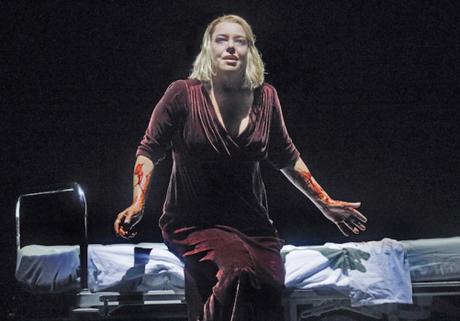
The Seven-Year Itch
Wagner’s earliest triumph, Der fliegende Holländer, more commonly known as The Flying Dutchman (named after the doomed hero Vanderdecken’s ship), has not had a frequently recurring history at the opera house of late. In fact, and true to the title character’s own predicament, the work was last staged at the Metropolitan about seven seasons ago. My, how time flies!
Nevertheless, this latest revival of August Everding’s 1989 production (the fellow who supervised the Karajan Ring mentioned above), with sets by Hans Schavernoch, costumes by Lore Haas, lighting by Gil Wechsler, and conducted by the young musical prodigy Yannick Nézet-Séguin, drew mostly mild reviews, except in the case of powerhouse American soprano Amber Wagner as Senta.
Amber, if I may call her by her first name, provided vocal amplitude and startlingly expressive thrust to the role of the “good woman” that Wagner always envisioned for Senta. She is the one person who will redeem the Dutchman from his curse after centuries of wandering the earth’s oceans. The Metropolitan Opera Guild’s magazine, Opera News, in its July 2017 review of the production, noted that “[t]here was a considerable shift in scale in Act II with the arrival of Amber Wagner.” They weren’t joking!
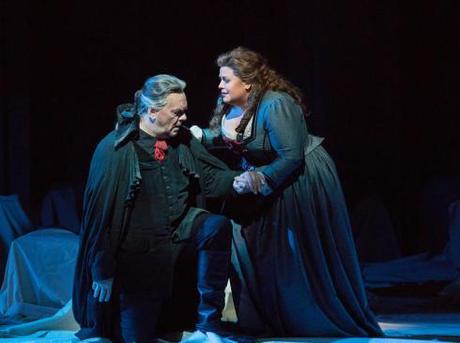
After a briskly paced run-through that maestro Yannick gave the thrice-familiar Overture, the wonderful men’s chorus burst out in mellow song with some hearty “Ho-heys!” and “Hoyohos!” Here was top-notch, full-throated singing for once. Things moved along at a swift enough speed, with Daland, Senta’s father (German bass Franz-Josef Selig), shouting orders to the obedient if sleepy-eyed Steersman (sung by tenor Ben Bliss), until the mysterious Phantom made his entrance (descending a rickety ladder?).
The Dutchman’s lengthy exposition (here we go again!), whereby, in the manner of Isolde’s Narration, he describes his situation to the audience, needed more thrust and a heftier ring to its pronouncements. Past interpreters such as the Belgian bass-baritone José van Dam, the indelible George London, Hermann Udhe (who brought a haunted quality to the part) or Hans Hotter in his heyday, not to mention Thomas Stewart, and (at New York City Opera) Guillermo Sarabia, all boasted an individuality and/or personalization to the ominous discourses of this Wagnerian antihero.
Try as he might, German baritone Michael Volle’s Dutchman’s displayed more modest means. While they made their points — thanks largely to his splendid diction — they lacked that heavy layer of tragic inevitability. The basic theme of this work, i.e., redemption, is always within reach but never, ever attained. The Dutchman’s curse follows him wherever he goes. It darkens his steps, it permeates his soul. And in his monologue, “Die Frist ist um!” (“The time is up!”), he expresses all his loathing and hate, as well as his never-ending hope for release. Volle’s previous assignment as Hans Sachs in Die Meistersinger made one sit up and take notice. In this instance, I would have preferred that he had rocked the boat some more. That could have animated his going about his duties somewhat.
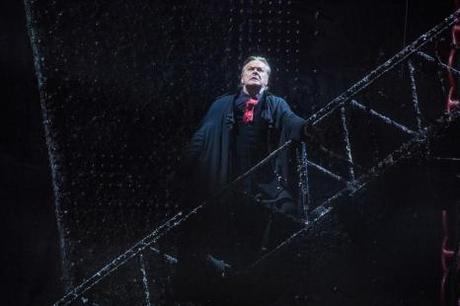
Things picked up considerably in Act II (as noted above), with Amber Wagner’s intensely concentrated performance of Senta’s Ballad. When she joined in unison with Volle for their soul-searching duet; then, in the trio with Selig, Volle and herself, Wagner outshone (and out-sang) them both. Brava! Another robust voice — that of veteran mezzo Dolora Zajick as Mary — came through loud-and-clear over the airwaves. It’s a shame the part is a short one. I imagine that, at this stage in her career, Zajick would still make a superbly malevolent Ortrud in Wagner’s Lohengrin.
American tenor AJ Glueckert (taking over for the previously announced Jay Hunter Morris) made his Met broadcast debut as Senta’s betrothed Erik. He has a warm, mellow tone which brought youthful impetuosity to the part. Not surprisingly, Morris’ withdrawal from this assignment cleared the way for Glueckert’s success. We hope to hear more of this fine young singer.
In seasons long past, the Met used to perform The Flying Dutchman in three acts, with two intermissions. Wagner sanctioned this edition, and made some judicious comprises where theaters were concerned (but not always, as we witnessed with Tannhäuser in Paris). For presenting the opera in one continuous act, I’m grateful. I am not so satisfied that the Met has never given a though to producing Wagner’s ORIGINAL version of this opera, with its reduced orchestration and the elimination of the redemption theme.
THAT version exists only on DVD and CDs. The live performance from the 1985 Bayreuth Festival by legendary director Harry Kupfer of this edition is a one-of-a-kind presentation. It turns the story on its head by having Senta present on stage from beginning to end. There is no “redemption theme,” either in the Overture or at the conclusion. The opera simply ends, with the Norwegian villagers shutting their windows on Senta as she awakes from her reverie.
Senta is obsessed with the Dutchman’s portrait right from the start (an important plot point that appears only in Act II). Clutching the portrait for dear life, Senta takes it with her wherever she goes. This version, known as “Senta’s Dream,” is well within the composer’s scope for director Kupfer to have focused on her as the central participant.
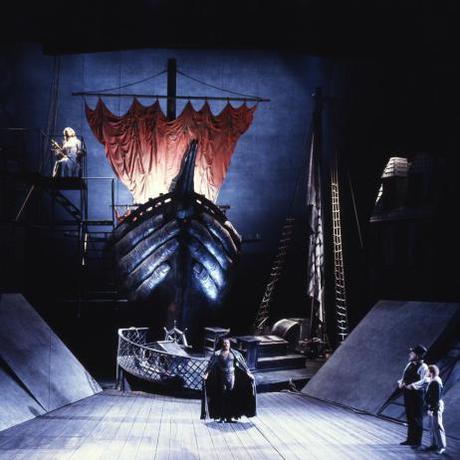
Danish soprano Lisbeth Balslev is the neurotically enraptured Senta, along with the fabulous Dutchman of African American bass-baritone Simon Estes, who with his noble core and rock-solid vocal output gives the performance of a lifetime. In this edition, the Dutchman is strapped to his ship’s mast in a Christ-like pose. The ship’s prow is shaped like two giant praying hands; it opens up to reveal its ghostly contents. Shudder….
The production premiered in 1978 and is considered one of the finest stage treatments of the Dutchman’s tale. It also had the requisite passion that the Met’s tired old production so sorely lacked.
Copyright © 2017 by Josmar F. Lopes
Advertisements
